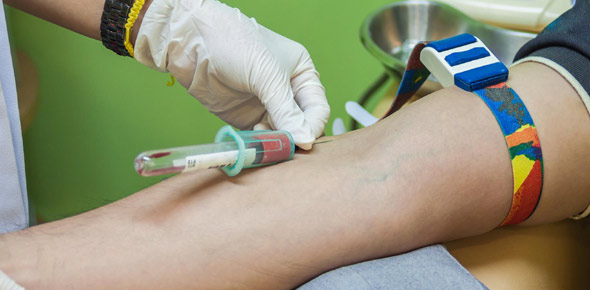THE VENIPUNCTURE SITE SHOULD BE CLEANSED WITH?
WHEN PERFORMING A VENIPUNCTURE, IF YOU HAVE THE PATIENT __________ THE...
IN THE EVACUATED BLOOD COLLECTION SYSTEM THE EVACUATED GLASS TUBES...
A __________ IS A SMALL, STERILE, NEEDLE LIKE PIECE OF METAL USED TO...
THE STANDARD POINT OF THE LANCET TO BE USED WHEN COLLECTING BLOOD FROM...
THE LID TO THE CENTRIFUGE SHOULD BE KEPT __________ WHEN IN USE?
AT THE LOCATION WHERE YOU ARE GOING TO FEEL FOR A VEIN, WRAP THE...
IF DURING A VENIPUNCTURE, A PATIENT HAS A SYNCOPAL EPISODE, WHAT WOULD...
THE MOST IMPORTANT STEP IN THE PERFORMANCE OF A VENIPUNCTURE IS?
AN INSTRUMENT CALLED A CENTRIFUGE?
WHEN PERFORMING A VENIPUNCTURE, THE TOURNIQUET SHOULD BE WRAPPED...
THE BLOOD LANCET IS USED FOR THE COLLECTION OF BLOOD SPECIMENS BY?
WHICH NEEDLE GAUGES ARE MOST COMMONLY USED FOR VENIPUNCTURE?
THE CEPHALIC, MEDIAL CUBITAL, AND BASILIC VEINS ARE __________ USED...
WHEN COLLECTING BLOOD BY SKIN PUNCTURE ON AN INFANT, YOU SHOULD USE A?
WHEN CLEANSING THE VENIPUNCTURE SITE, IT IS GOOD PRACTICE TO:
TO DETERMINE THE SIZE OF THE NEEDLE REMEMBER THAT THE HIGHER THE GAUGE...
USE YOUR INDEX FINGER WHEN YOU __________ FOR A VEIN?
ARTERIOLES ARE THE SMALLES TYPE OF?
WHICH OF THESE LAB TESTS MONITOR ANTICOAGULATION THERAPY?
WHICH ONE OF THE FOLLOWING EVACUATED TUBES WOULD BE DRAWN FIRST?
THE MAXIMUM TIME A TOURNIQUET SHOULD BE TIED ON THE UPPER ARM WHILE...
TO CLEANSE THE TYPICAL VENIPUNCTURE SITE, BEGIN AT THE INTENDED SITE...
IT IS VERY IMPORTANT WHEN PERFORMING A CAPILLARY STICK TO DO WHICH OF...
WHEN USING A CENTRIFUGE, MAKE SURE EQUAL WEIGHTS ARE?
DURING A VENIPUNCTURE, TO SECURE THE NEEDLE DURING INSERTION INTO THE...
THE MOST APPROPRIATE SITE FOR PERFOMING A CAPILLARY PUNCTURE IN A...
WHEN DOING A VENIPUNCTURE THE SYRINGE OR TUBE SHOULD BE __________ THE...
WHEN ANTICOAGULATED BLOOD IS CENTRIFUGED __________ GOES TO THE TOP OF...
A(N) __________ REQUIRES THE PATIENT TO BE FASTING & THEN BLOOD IS...
PREPARING FOR A GLUCOSE TOLERANCE TEST __________ HOURS BEFORE OR...
THE COLOR CODING FOR A STOPPER OF A TUBE WITH NO ADDITIVES IS (FOR...
WHEN ANTICOAGULATED BLOOD IS CENTRIFUGED __________ GOES TO THE BOTTOM...
THE TUBE USED TO COLLECT A BLOOD SAMPLE FOR A COMPLETE BLOOD COUNT...
WHAT TYPE OF BLOOD SAMPLE WILL BE NEEDED TO PERFORM A HEMOGLOBIN TEST?
WHEN COLLECTING BLOOD FOR A HEMATOCRIT TEST USE A?
__________ VALUES ARE INCREASED IN INFECTIONS & INFLAMMATORY...
WHAT TYPE OF BLOOD SAMPLE IS NEEDED WHEN PERFORMING A PKU?
IN DRUG TESTING THE __________ REGULATES DESCRIBE HOW EVIDENCE IS TO...
WHEN COLLECTING BLOOD FOR CHOLESTEROL TESTS USE A __________ TOP...
RUBBER SLEEVES ON AN EVACUATED TUBE SYSTEM MAKE IT POSSIBLE FOR?
HOW MANY HEMATOCRIT TUBES SHOULD BE COLLECTED FROM THE PATIENT?
WHICH OF THE FOLLOWING IS FALSE?
MAKING SURE THAT A TUBE IS CORRECTLY LABELED WITH THE PATIENT'S...
PERFORMING A __________ AS PART OF A COMPLETE COUNT DETERMINES THE...
WHEN USING AN EVACUATED TUBE FOR COLLECTION OF ELECTROLYTES USE A?
THE TUBE TO COLLECT WHOLE BLOOD WITH AN ADDITIVE IN IT HAS A...
WHEN PERFORMING A VENIPUNCTURE, IF NO BLOOD FLOWS INTO THE TUBE, HOW...
SODIUM CITRATE IS AN ANTICOAGULANT OF CHOICE FOR COAGULATION STUDIES...
THE PRIMARY ANTICOAGULANT ADDITIVE EDTA REMOVES CALCIUM BY FORMING...

















